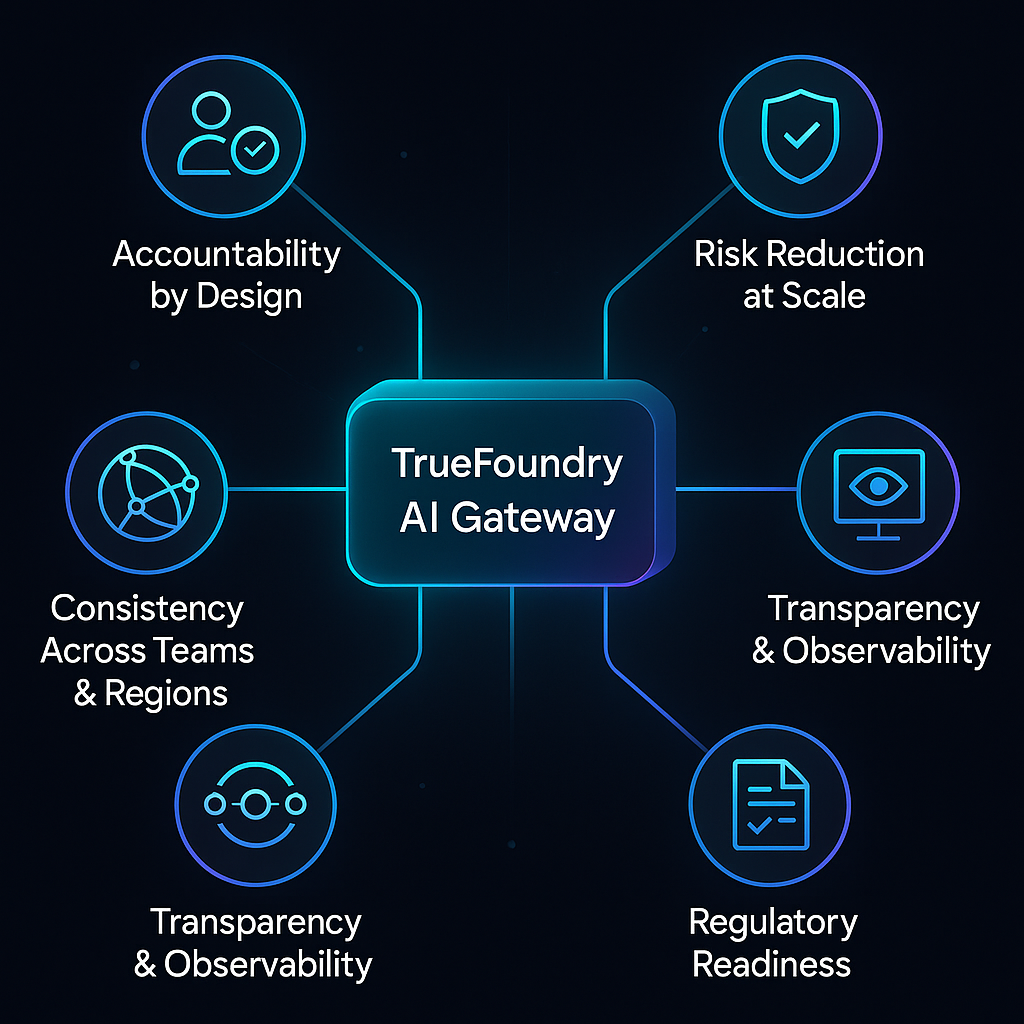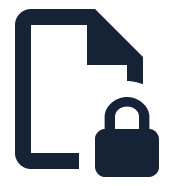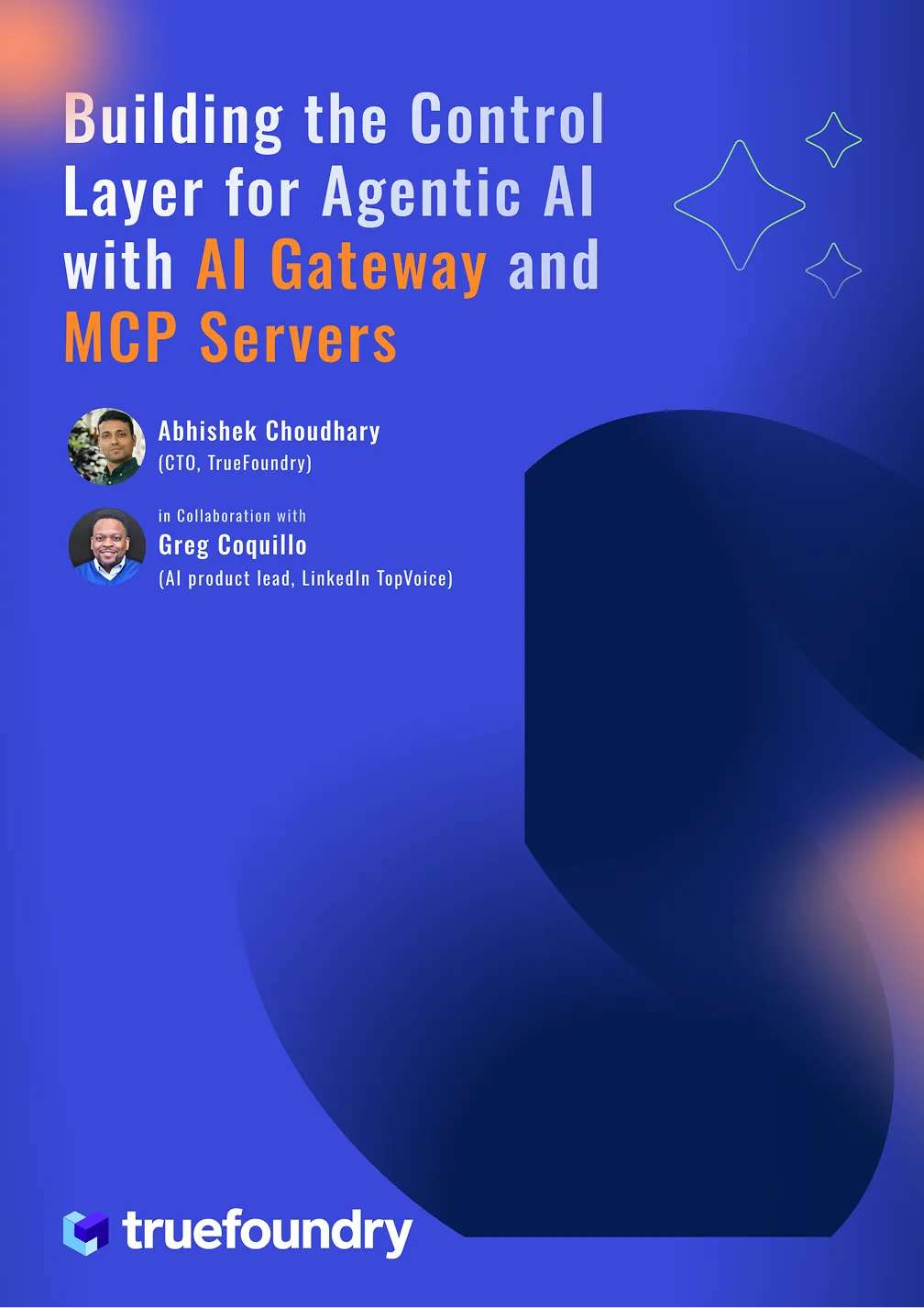What Is an AI Governance Framework?
Introduction
Artificial intelligence has evolved from experimental tools into mission-critical business infrastructure. Today, it drives decisions, automates workflows, and powers customer experiences across industries. But as AI systems scale, so do the risks — from data bias and model opacity to security lapses and accountability gaps. These challenges demand more than policies; they demand enforceable, technology-driven governance.
An AI governance framework provides the foundation for using AI responsibly — defining policies, standards, and oversight mechanisms to ensure every model aligns with ethical, legal, and organizational goals. Yet, translating these frameworks into daily practice requires infrastructure.
That’s where AI Gateways come in. Acting as the control plane between applications and models, a gateway can centralize access management, apply content guardrails, log every model call for audit, and enforce compliance policies at scale. As regulations like the EU AI Act, NIST AI RMF, and ISO 42001 reshape global standards, enterprises need both frameworks and infrastructure. Governance defines the “what” and “why.” The AI Gateway delivers the “how.”
What Is an AI Governance Framework - and How AI Gateway Operationalizes It
An AI governance framework is a structured system that defines how artificial intelligence is designed, deployed, and monitored across an organization. It sets the rules, responsibilities, and safeguards that ensure AI operates ethically, transparently, and in compliance with business and regulatory standards. In essence, it provides a blueprint for building AI systems that are accountable, explainable, and trustworthy.
A robust governance framework brings clarity to every stage of the AI lifecycle — from data collection and model validation to deployment and ongoing monitoring. It defines who is responsible for data quality, how decisions are audited, and how risks such as bias, privacy violations, or misuse are detected before they cause harm.
However, governance frameworks often stop at documentation — while enforcement remains fragmented. This is where TrueFoundry’s AI Gateway bridges the gap between policy and practice. Acting as the control plane for enterprise AI, the Gateway operationalizes governance by embedding it directly into the infrastructure layer.
Through a single, centralized interface, AI Gateway can:
- Enforce access and authorization policies across all models and users
- Validate and normalize model requests to ensure input consistency
- Mask or redact sensitive data before it reaches external providers
- Maintain unified, auditable logs for every model interaction
- Apply guardrails and routing rules to prevent non-compliant or high-risk behavior
This means governance principles are not manually applied team by team - they’re automatically executed at scale.
Core Objectives of AI Governance (Enabled by TrueFoundry’s AI Gateway)
- Establish clear accountability: Role-based access controls and audit logs ensure every request is traceable.
- Maintain transparency: Centralized observability gives compliance teams full visibility into model usage and performance.
- Ensure compliance: Policy-driven routing and guardrails enforce data residency, fairness, and ethical constraints automatically.
Unlike traditional IT governance, AI governance must manage dynamic, evolving systems that learn over time. TrueFoundry’s Gateway supports continuous model assessment, explainability checks, and real-time monitoring, ensuring AI remains aligned with human and organizational intent — even as it adapts.
Key Outcomes of a Gateway-Enabled Governance Framework
- Reduced regulatory and reputational risk through consistent enforcement
- Improved data integrity and decision transparency across all models and regions
- Stronger stakeholder trust in AI-driven operations
- Lower operational overhead, as governance logic is centralized, not duplicated
Ultimately, TrueFoundry’s AI Gateway turns governance from a static framework into a living, programmable system - one where compliance, ethics, and transparency are built into every API call. It transforms AI from a technical initiative into a responsible enterprise capability, empowering innovation that’s as secure and compliant as it is intelligent.
Why Your Organization Needs AI Governance and a Gateway to Enforce It
AI is now woven into the core of enterprise operations from customer analytics and product recommendations to fraud detection and strategic decision-making. But as adoption accelerates, so do the risks: biased outputs, opaque decision logic, privacy breaches, and unpredictable model behavior.
Without a unified governance structure, even the most advanced AI systems can become compliance liabilities or reputational risks. Policies written in documents aren’t enough; governance must be executed through infrastructure continuously, automatically, and transparently.
That’s why enterprises are turning to TrueFoundry’s AI Gateway as the foundation for responsible AI operations.
It acts as a programmable control plane that enforces governance frameworks in real time across every model, team, and environment. Instead of scattering compliance logic across multiple applications, the Gateway centralizes it, ensuring consistent oversight and accountability.
How TrueFoundry’s AI Gateway Operationalizes Governance
- Accountability by Design: Every model call passes through the Gateway, which tags it with user identity, timestamp, and metadata. This creates a complete audit trail for regulators and internal reviews — making ownership visible and provable.
- Risk Reduction at Scale: The Gateway applies guardrails, content filters, and data privacy policies automatically. It can block non-compliant requests, enforce rate limits, and redact sensitive information before it ever leaves your environment.
- Consistency Across Teams and Regions: TrueFoundry’s centralized interface ensures all teams from R&D to production use standardized model APIs, prompt templates, and schemas. Governance rules and usage policies propagate instantly across geographies and providers.
- Transparency and Observability: With unified logs and dashboards, the Gateway provides real-time visibility into which models are being used, how they perform, and what data they touch, turning compliance from a periodic task into a continuous process.
- Regulatory Readiness:
As frameworks like the EU AI Act, NIST AI RMF, and ISO 42001 evolve, TrueFoundry’s AI Gateway allows enterprises to adapt instantly updating routing, access, or audit policies through configuration, not code.

Ultimately, having a governance framework is not about limiting innovation but about enabling it responsibly. It gives organizations the structure to experiment with confidence, knowing that every model deployed is compliant, auditable, and aligned with ethical and business goals.
In practice, implementing these guardrails across diverse AI providers is complex. AI Gateways simplify this by providing a single control surface for authentication, usage tracking, and compliance enforcement. Instead of scattering governance logic across applications, teams configure it once at the gateway — achieving accountability and observability by design.
Key Principles Behind AI Governance Frameworks
Every effective AI governance framework is built on a set of foundational principles that ensure AI systems operate responsibly, securely, and in alignment with organizational values.
But defining these principles is only half the challenge enforcing them across multiple models, APIs, and teams requires a unified infrastructure.
That’s where TrueFoundry’s AI Gateway comes in. Acting as the enforcement layer of governance, it embeds these principles directly into the AI stack through centralized routing, access control, observability, and guardrails. Below are the five core principles of AI governance — and how TrueFoundry makes each one operational in real-world enterprise environments.
1. Transparency and Explainability: AI systems must be understandable to developers, auditors, and end users alike.
TrueFoundry’s Gateway makes this possible through end-to-end traceability and unified logging. Every request and response - including prompt, latency, token usage, and model version — flows through the Gateway, creating a single, explainable audit trail.
This central visibility not only simplifies compliance audits but also supports model comparison, performance analysis, and explainability reporting all within one dashboard.
2. Fairness and Non-Discrimination: Governance frameworks require that AI outputs remain fair, unbiased, and equitable.
TrueFoundry enables this through policy-based routing and programmable guardrails. Queries can be automatically directed to validated or bias-tested models, while the Gateway can flag or filter outputs that violate fairness constraints.
This ensures consistent, organization-wide enforcement of fairness standards — across models, business units, and regions.
3. Accountability and Oversight: A cornerstone of governance is clear ownership of AI decisions.
TrueFoundry’s Gateway enforces role-based access control (RBAC) and per-user rate limits, linking every model interaction to an identifiable owner.
Through its built-in audit logging and identity-aware routing, organizations can instantly trace who accessed which model, when, and for what purpose turning accountability into measurable, enforceable data rather than a manual process.
4. Privacy and Security: Data privacy is non-negotiable in enterprise AI.
TrueFoundry’s Gateway acts as a secure boundary between applications and model providers — encrypting all traffic, masking personally identifiable information (PII), and enforcing token-level access policies.
By funneling all model traffic through this governed perimeter, organizations achieve compliance with GDPR, CCPA, and data residency laws automatically, without rewriting application code or managing fragmented connectors.
5. Human-Centric Design: Even as automation scales, human judgment must remain in control of critical AI-driven outcomes.
TrueFoundry’s Gateway operationalizes this through programmable guardrails and human-in-the-loop workflows.
For example, it can automatically flag high-risk or policy-sensitive outputs for manual review before returning them to end users ensuring that human oversight is embedded directly into runtime, not bolted on afterward.
In essence, TrueFoundry’s AI Gateway transforms governance principles into executable, continuously enforced policies.
Instead of relying on scattered scripts or manual reviews, enterprises gain a unified control plane that enforces transparency, fairness, accountability, privacy, and human oversight — automatically and at scale.
5 Best AI Governance Frameworks for 2025
As artificial intelligence scales globally, a growing number of frameworks are emerging to help organizations govern it responsibly. These frameworks combine ethical, technical, and legal principles to ensure AI remains trustworthy and compliant. Below are five of the most influential AI governance frameworks shaping enterprise strategy in 2025.
1. EU AI Act
The European Union AI Act is the world’s first comprehensive, legally binding AI regulation. It categorizes AI systems by risk level and enforces strict compliance for high-risk applications.
- Applies to all AI systems operating in or impacting the EU market
- Risk tiers: Unacceptable, High, Limited, and Minimal
- Prohibits social scoring and biometric surveillance misuse
- Requires transparency, data governance, and human oversight for high-risk systems
Penalties: Up to €35 million or 7% of global annual turnover
2. NIST AI Risk Management Framework (AI RMF)
Developed by the U.S. National Institute of Standards and Technology (NIST), this voluntary framework guides organizations in managing AI risks through practical, adaptable controls.
- Based on four functions: Govern, Map, Measure, and Manage
- Promotes trustworthy, transparent, and explainable AI
- Widely adopted by U.S. government agencies and private enterprises
- Aligns with ISO/IEC 42001 and global AI ethics standards
3. UK Pro-Innovation AI Framework
The UK’s Pro-Innovation AI Framework takes a principles-first, non-statutory approach designed to encourage responsible innovation.
- Built on five principles: Fairness, Accountability, Transparency, Safety, and Contestability
- Emphasizes flexibility and proportional regulation
- Enables organizations to innovate without heavy compliance burdens
- Provides a foundation for future UK AI legislation
4. OECD AI Principles
Adopted by over 46 countries, the OECD AI Principles are globally recognized guidelines for ethical and human-centered AI.
- Non-binding but highly influential worldwide
- Focus on human-centered, transparent, and accountable AI
- Encourage continuous policy adaptation by governments
- Serve as a foundation for G20 and G7 AI codes of conduct
5. U.S. Executive Order on Artificial Intelligence (EO 14179)
Signed in 2025, the Executive Order 14179 titled “Removing Barriers to American Leadership in Artificial Intelligence” sets national priorities for AI development and oversight.
- Directs federal agencies to strengthen AI governance and risk management
- Emphasizes fairness, national security, and public safety
- Builds on earlier orders and the AI Bill of Rights
- Reinforces U.S. leadership in safe, innovation-driven AI
Together, these frameworks form the global foundation for AI governance. They provide organizations with practical, ethical, and regulatory guidance to balance innovation with accountability in 2025 and beyond. While these frameworks define global standards, organizations still need technical systems that can implement them consistently. AI Gateways act as that enforcement layer, translating policy into action through centralized governance, monitoring, and auditing.
How to Select Your Enterprise AI Governance Structure
Selecting the right AI governance structure determines how effectively your organization can manage risk, compliance, and innovation at scale. But governance cannot remain a static document or committee; it must live within the AI infrastructure itself.
This is where AI Gateways redefine governance. Acting as the programmable control plane for your enterprise AI ecosystem, a gateway unifies access, security, observability, and compliance across every model and provider. It enforces the rules your governance framework defines—automatically, consistently, and audibly.
A strong governance structure combines three pillars: leadership ownership, process design, and infrastructure enforcement. Below is how AI Gateways enable each.
1. Establish Leadership Ownership: Governance starts with accountability. Form an AI Governance Council or Ethics Committee that defines enterprise-wide AI principles, risk thresholds, and compliance standards.
The AI Gateway becomes the council’s technical enforcement layer—translating those policies into runtime rules. For example, when leadership sets “PII must never leave EU data centers,” the gateway enforces that through region-aware routing and data residency policies without additional engineering work.
2. Define Roles and Responsibilities: Clear ownership across the AI lifecycle prevents governance gaps.
With a Gateway in place, access roles can be tied directly to responsibilities—developers, auditors, and business units can each have scoped permissions and rate limits. Every model invocation is automatically linked to a user identity and logged, turning accountability into an operational metric, not a compliance checklist.
3. Integrate Compliance into Operations: Traditional governance models rely on manual reviews; AI Gateways automate them.
Gateways sit between your applications and AI providers, applying guardrails, content filters, and bias detection policies in real time. This integration ensures that compliance is not an afterthought in deployment pipelines but a built-in stage of every AI workflow.
For example, before a model response is returned, the Gateway can check it against approved formats, remove sensitive data, and tag logs for audits—all transparently to end users.
4. Leverage Technology for Oversight: Governance demands visibility. Gateways provide centralized observability aggregating model metrics, token usage, latency, and error rates across providers.
Through one dashboard, risk officers and engineering teams can monitor model performance, policy violations, or anomalous usage patterns. This turns governance from static documentation into a real-time monitoring system.
TrueFoundry’s AI Gateway, for instance, enables fine-grained policy control, unified logging, and cost tracking per user or team ensuring operational oversight without friction.
5. Adopt a Risk-Based Approach: Not all AI systems carry the same risk profile. Gateways help automate risk stratification by tagging each model or endpoint with its risk level, routing high-risk tasks through stricter policies (such as content moderation or human validation).
This dynamic routing ensures resources and oversight are concentrated where accountability matters most without slowing down lower-risk innovation.
6. Ensure Continuous Review: Governance must evolve as your models and regulations do. Gateways enable continuous feedback loops by capturing metrics and logs that inform audits, bias reviews, and retraining triggers.
When combined with leadership oversight, this creates a closed governance loop:
policy → enforcement → observation → improvement.
By aligning leadership intent with a gateway-based enforcement layer, enterprises can move beyond checkbox governance.
They gain a living system that enforces rules automatically, adapts to change, and proves compliance through data. TrueFoundry’s AI Gateway transforms governance from a reactive control mechanism into an intelligent, scalable framework where every AI call is secure, explainable, and policy-compliant by default.
How to Adapt Governance for Evolving AI Systems
AI systems don’t stand still. They learn, retrain, and evolve continuously often faster than traditional governance models can adapt. As data changes and models self-improve, static checklists and manual reviews are no longer enough.
Modern governance must be dynamic, data-driven, and enforced at runtime. That’s precisely where TrueFoundry’s AI Gateway transforms governance from a static framework into a living system.
1. Make Governance Observable in Real Time
Adaptive governance starts with visibility. TrueFoundry’s AI Gateway provides real-time observability across every model, tool, and API.
Every interaction — prompt, response, latency, token count, or error passes through the gateway, creating a continuous audit trail. This allows compliance teams to detect drift, bias, or abnormal behavior as it happens, not months later during an audit.
By making model behavior observable, the gateway turns governance into an always-on monitoring system.
2. Automate Policy Enforcement and Dynamic Routing
AI policies shouldn’t depend on human intervention to stay compliant. TrueFoundry’s Gateway enforces them automatically at the API layer.
It can dynamically route queries based on risk, geography, or sensitivity — for instance:
- Route financial data requests only to approved models hosted in-region.
- Use smaller, open-weight models for low-risk workloads to control cost.
- Failover automatically if a model or provider becomes non-compliant.
These routing rules make governance adaptive: the infrastructure itself responds to regulatory and operational changes without halting innovation.
3. Modularize Governance Components
Static frameworks fail when every update requires re-architecture. TrueFoundry’s Gateway enables modular governance, where each control (security, privacy, content moderation, cost tracking) can evolve independently.
Need to update your data retention policy or compliance region? Adjust the Gateway’s configuration — not your application code.
This modularity allows organizations to evolve governance continuously, as new regulations or internal policies emerge.
4. Close the Human Feedback Loop
Automation ensures speed, but responsible governance needs human judgment. The Gateway enables human-in-the-loop workflows — automatically flagging high-risk outputs or policy violations for manual review.
For example, if a model generates sensitive or non-compliant content, the Gateway can pause the response, tag it for review, and log the event for future retraining.
This feedback mechanism blends human oversight with automated guardrails, ensuring governance stays both efficient and ethical.
5. Enable Continuous Learning from Metrics
Governance doesn’t end at enforcement — it improves with data.
Through unified logs and observability dashboards, TrueFoundry’s AI Gateway provides insights into usage patterns, model accuracy, and compliance metrics. These insights help refine routing policies, update fairness checks, and improve guardrail configurations.
In other words, the Gateway itself becomes the feedback engine that drives better governance decisions.
6. Build for Agility and Regulation Readiness
Regulatory expectations are changing rapidly — from the EU AI Act to sector-specific AI codes of conduct. With TrueFoundry’s Gateway, governance frameworks can adapt instantly through configuration updates rather than system overhauls.
When compliance zones shift or new standards arise, you can adjust routing, audit, and retention policies in minutes — ensuring governance scales as fast as innovation.
Conclusion
AI governance is no longer a policy conversation - it’s an infrastructure challenge. As organizations scale from a handful of models to complex, multi-provider ecosystems, governance can’t rely on manual reviews or static documents. It needs to be enforced in real time, across every API call, data flow, and model interaction.
That’s exactly where TrueFoundry’s AI Gateway transforms the landscape. It operationalizes governance frameworks turning principles like transparency, accountability, and fairness into executable rules. Through unified observability, access control, and policy-based routing, the Gateway ensures that every model request is secure, explainable, and compliant by default.
In a world defined by the EU AI Act, NIST AI RMF, and fast-evolving ethical expectations, enterprises need governance that moves as fast as their AI. TrueFoundry’s Gateway enables that agility, providing a programmable control plane where governance is built in, not bolted on.
By integrating governance at the infrastructure level, organizations can innovate confidently, knowing that trust, compliance, and accountability are continuously enforced, not just promised.
Built for Speed: ~10ms Latency, Even Under Load
Blazingly fast way to build, track and deploy your models!
- Handles 350+ RPS on just 1 vCPU — no tuning needed
- Production-ready with full enterprise support
TrueFoundry AI Gateway delivers ~3–4 ms latency, handles 350+ RPS on 1 vCPU, scales horizontally with ease, and is production-ready, while LiteLLM suffers from high latency, struggles beyond moderate RPS, lacks built-in scaling, and is best for light or prototype workloads.



















